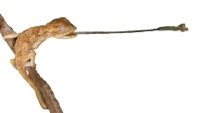Chameleon Care &
Information Center (CCIC)
Chameleon Care &
Information Center (CCIC)



Hybridization and Inbreeding - Contributed by Jason Descamps
Hybridization and Inbreeding are two very common practices in the field of herpetoculture. Many new and rare morphs are a direct result of hybridization and/or inbreeding. While many of these animals represent highly sought after specimens in the hobby, hybridization and inbreeding of chameleons is widely frowned upon. Chameleons are delicate creatures that are under tremendous pressure from outside sources and while many species are still being exported from their country of origin few are established in captive collections. Establishing captive bloodlines and easing the reliance on wild caught chameleons will become of the utmost importance as the next few years pass.
Hybridization
Hybrid animals represent the offspring of animals from two different species. While some evidence exists that indicates limited hybridization does occur in the wild intentional hybridization in captivity should be avoided at all times. When dealing with limited genetic resources, such as captive populations of chameleons, care should always be taken to strengthen the gene pool for the species. Producing hybrid animals only serves to deplete the available genes by removing an entire generation of animals from breeding opportunities. All captive keepers should strive to keep the bloodlines as pure as possible through genetic management systems.
Inbreeding
Inbreeding of captive herps has become increasingly popular over the last decade with many new morphs being produced through select inbreeding. These situations represent the other end of the herpetocultural spectrum and are being produced by hardy animals, which do well in captivity and that are firmly established within captivity. Chameleons in general are poorly established animals that have proven difficult to keep and breed in captivity. Being so difficult to care for has limited the genetic diversity within captive populations. Inbreeding of these animals further closes the door on genetic opportunities creating a closed bloodline that will, in time, begin to produce sub par animals which could eventually lead to the loss of the species in captivity. Inbreeding chameleons should be avoided in all but the most extreme cases. By outbreeding captive chameleons with other unrelated animals a strong captive population can be established amongst breeders.
Hybridization & Inbreeding
Copyright © 1998-2014 Christopher V. Anderson. All Rights Reserved.
Reproduction in whole or part is expressly forbidden without written permission.
For permission, please contact Christopher V. Anderson at cvanders@mail.usf.edu